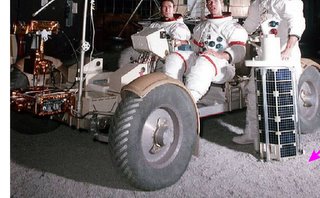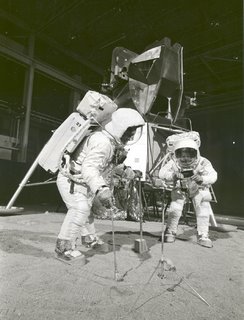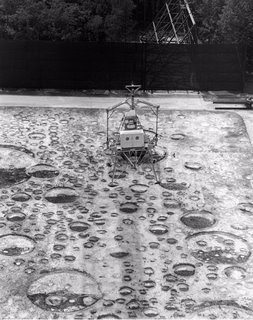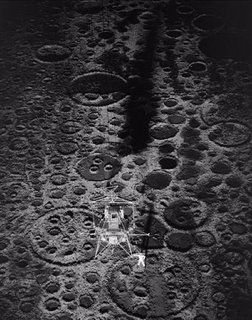NASA Spent Millions Building Moon Simulation Models
This is how nasa faked the moon landing. They used Hollywood style movie Props. Special Effects technicians picked over the models with microscopes to create very accurate details. Why go through so much trouble unless you're trying to trick someone?

Listen to what these NASA officials said about these models;
Looking down from the top of the gantry on to the simulated Lunar Surface. James Hansen writes: "To make the simulated landings more authentic, [Donald] Hewes and his men filled the base of the huge eight-legged, red-and-white structure with dirt and modeled it to resemble the moon's surface. They erected floodlights at the proper angles to simulate lunar light and installed a black screen at the far end of the gantry to mimic the airless lunar "sky." Hewes personally climbed into the fake craters with cans of everyday black enamel to spray them so that the astronauts could experience the shadows that they would see during the actual moon landing." (p. 375) From A.W. Vigil, "Piloted Space-Flight Simulation at Langley Research Center," Paper presented at the American Society of Mechanical Engineers, 1966 Winter Meeting, New York, NY, November 27 - December 1, 1966. "Ground-based simulators are not very satisfactory for studying the problems associated with the final phases of landing. This is due primarily to the fact that the visual scene cannot be simulated with sufficient realism. For this reason it is preferable to go to some sort of flight-test simulator which can provide real-life visual cues. One research facility designed to study the final phases of lunar landing is in operation at Langley. ... The facility is an overhead crane structure about 250 feet tall and 400 feet long. The crane system supports five-sixths of the vehicle's weight through servo-driven vertical cables. The remaining one-sixth of the vehicle weight pulls the vehicle downward simulating the lunar gravitational force. During actual flights the overhead crane system is slaved to keep the cable near vertical at all times. A gimbal system on the vehicle permits angular freedom for pitch, roll, and yaw. The facility is capable of testing vehicles up to 20,000 pounds. A research vehicle, weighing 10,500 pounds fully loaded, is being used and is shown [in this picture]. This vehicle is provided with a large degree of flexibility in cockpit positions, instrumentation, and control parameters. It has main engines of 6,000 pounds thrust, throttle able down to 600 pounds, and attitude jets. This facility is studying the problems of the final 200 feet of lunar landing and the problems of maneuvering about in close proximity to the lunar surface." Published in James R. Hansen, Spaceflight Revolution: NASA Langley Research Center From Sputnik to Apollo, (Washington: NASA, 1995), pp. 373-378.
Looking down from the top of the gantry on to the simulated Lunar Surface. James Hansen writes: "To make the simulated landings more authentic, [Donald] Hewes and his men filled the base of the huge eight-legged, red-and-white structure with dirt and modeled it to resemble the moon's surface. They erected floodlights at the proper angles to simulate lunar light and installed a black screen at the far end of the gantry to mimic the airless lunar "sky." Hewes personally climbed into the fake craters with cans of everyday black enamel to spray them so that the astronauts could experience the shadows that they would see during the actual moon landing." (p. 375) From A.W. Vigil, "Piloted Space-Flight Simulation at Langley Research Center," Paper presented at the American Society of Mechanical Engineers, 1966 Winter Meeting, New York, NY, November 27 - December 1, 1966. "Ground-based simulators are not very satisfactory for studying the problems associated with the final phases of landing. This is due primarily to the fact that the visual scene cannot be simulated with sufficient realism. For this reason it is preferable to go to some sort of flight-test simulator which can provide real-life visual cues. One research facility designed to study the final phases of lunar landing is in operation at Langley. ... The facility is an overhead crane structure about 250 feet tall and 400 feet long. The crane system supports five-sixths of the vehicle's weight through servo-driven vertical cables. The remaining one-sixth of the vehicle weight pulls the vehicle downward simulating the lunar gravitational force. During actual flights the overhead crane system is slaved to keep the cable near vertical at all times. A gimbal system on the vehicle permits angular freedom for pitch, roll, and yaw. The facility is capable of testing vehicles up to 20,000 pounds. A research vehicle, weighing 10,500 pounds fully loaded, is being used and is shown [in this picture]. This vehicle is provided with a large degree of flexibility in cockpit positions, instrumentation, and control parameters. It has main engines of 6,000 pounds thrust, throttle able down to 600 pounds, and attitude jets. This facility is studying the problems of the final 200 feet of lunar landing and the problems of maneuvering about in close proximity to the lunar surface." Published in James R. Hansen, Spaceflight Revolution: NASA Langley Research Center From Sputnik to Apollo, (Washington: NASA, 1995), pp. 373-378.


It turns out that NASA spent a lot of apollo moon money on the ground building moon models. Supposedly they did this so that they could run simulations. However, these models provide perfect props for movie special effects. This video even shows 'simulation' run throughs recorded before apollo 11 that look exactly like what we were told was real footage from the mission. That is until they pull the camera off of the rig and show the interior of the room where it's being filmed. Real tricky stuff.
NASA Moon Landing Hoax Pt.3
And you should check out these pages too, lots of great info;
Apollo moon hoax
Apollo Reality











1 Comments:
The APOLLO REALITY website has moved to:-
http://apolloreality.atspace.co.uk
Post a Comment
<< Home